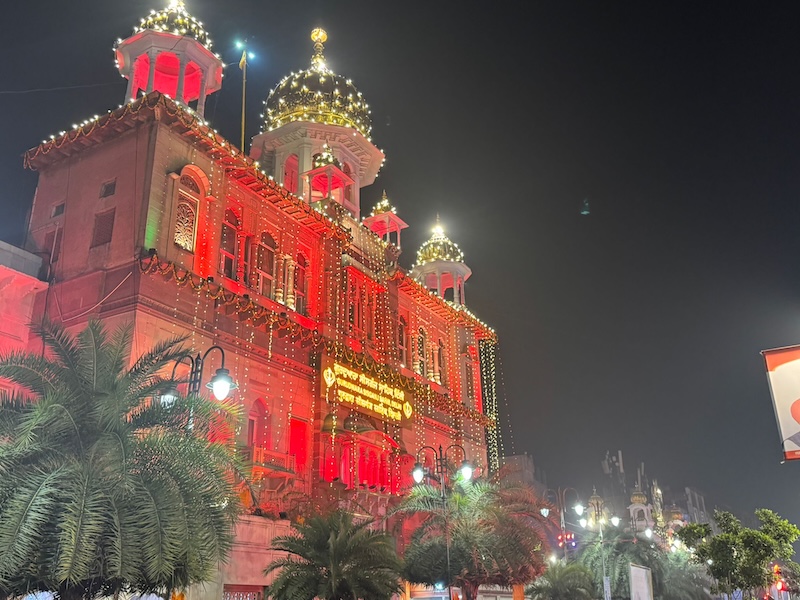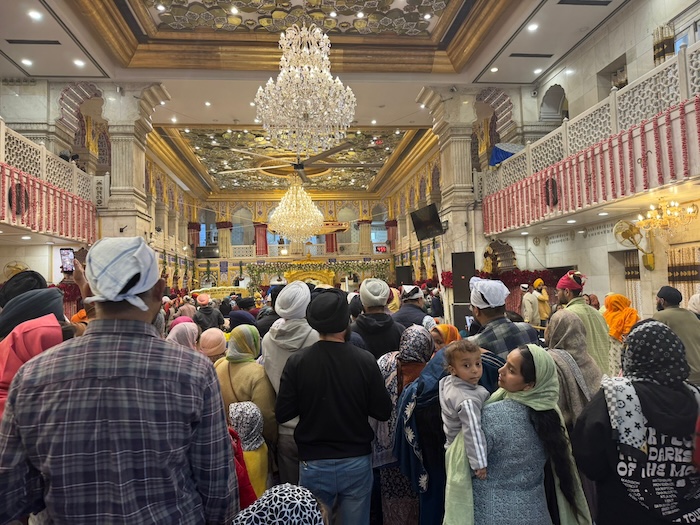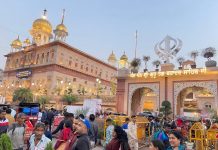
By Daljit Singh Khalsa | Experience |
Earlier this week, as I walked through the storied lanes of Chandni Chowk, I felt an irresistible pull drawing me towards Gurdwara Sis Ganj Sahib. Long before my eyes met the sacred domes, a serene and powerful presence descended upon me — a presence so tender, yet so majestic, that it felt as though Guru Tegh Bahadur Sahib Ji Himself was guiding my steps. In that moment, the bustling city seemed to fall away, replaced by a quiet spiritual embrace.
The entire vicinity was overflowing with devotees. Every passageway, every balcony, every open space throbbed with life, as multitudes gathered not simply to visit a historical shrine, but to receive the Guru’s eternal grace on the sacred occasion of Shaheedi Diwas. What touched me deeply was the diversity of faces — Sikhs, Hindus, Muslims and people of various traditions — all standing together in reverence for the Guru who surrendered his life so that others might live with freedom of belief. His compassion had transcended boundaries then, and continues to do so even now.
Inside, the Gurdwara shone with a divine quietude. Fresh blossoms, lovingly arranged, adorned every corner, and the sangat resonated with heartfelt Simran. The sangat’s devotion carried the weight, depth, and gratitude of 350 years of remembrance. Just nearby, the Red Fort — a witness to the very events that shaped Sikh destiny — hosted the grand samagam honouring the supreme martyrdom on 24 November 1675, when the Ninth Guru offered His sacred head for the protection of human dignity.
As I stood before the sanctum, time itself seemed to soften. I could almost behold that fateful moment when the executioner’s sword fell in Chandni Chowk — when a saint of fifty-four years, clothed in serenity and sovereign courage, offered his life so the oppressed could keep their faith. Three and a half centuries have passed, yet his sacrifice continues to burn like an immortal flame, illuminating the hearts of millions across the world.

Wherever I travelled — Delhi, Amritsar, Anandpur Sahib — I felt the same spiritual tide rising among the people. The gurdwaras were filled not out of mere tradition, but out of profound love and devotion. People came in unending streams, holding candles of remembrance for the Guru who defended truths that were not his own. It became clear to me that Guru Tegh Bahadur Sahib Ji is not claimed by a single community — he stands as a guardian of all humanity.
In reflection, my heart returned to the journey of this saint-warrior. Born in 1621 in Amritsar, nurtured in a home where scripture and sword rested side by side, he grew into a Guru who travelled tirelessly through towns and remote villages. His presence dissolved caste, uplifted the downtrodden, and awakened courage among those crushed by despair. From Bakala to Anandpur, from Patna to Assam, he brought a message of equality that reached far beyond the boundaries of Punjab.

It was this very compassion that drew a group of Kashmiri Pandits to him in the summer of 1675. Though their faith differed from his, their suffering pierced his heart. When his young son asked who could confront such tyranny, the Guru responded with quiet strength. He knew the path to Delhi led only to martyrdom, and yet he walked it with the tranquillity of one who has surrendered wholly to the Divine Will.
In Chandni Chowk, he was offered three choices: perform a miracle, embrace Islam or face death. He chose death — not for glory, not for power, but so that the light of religious freedom might never be extinguished. When the sword descended, the heavens themselves seemed to tremble. His sacred head was carried to Anandpur under the cloak of night; his body was cremated by a Sikh who set fire to his own home so that the Guru’s remains would not be desecrated.
Standing in Sis Ganj Sahib, I realised that these were not distant events — they were living truth. His martyrdom reshaped history, inspired the creation of the Khalsa by Sri Guru Gobind Singh Ji, and laid the foundation for standing fearlessly against injustice of every kind.
Guru Tegh Bahadur Sahib Ji’s eternal message continues to echo across the ages:
ਭੈ ਕਾਹੂ ਕਉ ਦੇਤ ਨਹਿ ਨਹਿ ਭੈ ਮਾਨਤ ਆਨ ॥
Bhai kahu ko det nahin, nah bhai manat aan.
“Be fearless, and cause no fear.”
In a world still burdened by coercion and conflict, his example remains a guiding star. His courage is not only Sikh heritage — it is human heritage. His life teaches us that to protect the freedom of another is to deepen our own spiritual truth.
As I stepped out of Gurdwara Sis Ganj Sahib, my heart felt transformed. The fragrance of flowers, the melodious Simran, the collective reverence of the sangat — all merged into one sacred whisper: Remember the day. Remember the sacrifice. Remember the Guru who offered His head so that humanity could keep its soul.
physical structures, but the very soul of Anandpur Sahib.

Daljit Singh Khalsa, a UK-based practitioner with over 50 years of experience in both medical and mental health field, is a devout Sikh and an avid traveller. Physical fitness, spiritual discipline and sewa(selfless service) form the core of my daily practice.
RELATED STORY:
Between Spectacle and Denial: Delhi’s Ambivalent Treatment of Sikhs (Asia Samachar, 29 Oct 2025)
ASIA SAMACHAR is an online newspaper for Sikhs / Punjabis in Southeast Asia and beyond. You can leave your comments at our website, Facebook, Twitter, and Instagram. We will delete comments we deem offensive or potentially libelous. You can reach us via WhatsApp +6017-335-1399 or email: asia.samachar@gmail.com. For obituary announcements, click here

































